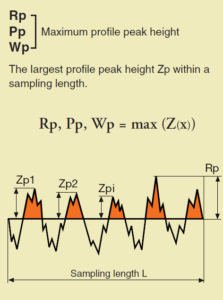Rp: What it is and Why We Dig It
Surface roughness, or how bumpy or smooth a surface is, plays a big part in making stuff in all kinds of industries, whether we’re talking about cars, airplanes, or manufacturing. One big player in figuring out surface roughness is Rp, or Peak Roughness Height. It’s key in figuring out how well a part’s gonna do its job and how long it’s gonna last. In this article, we’ll dive into what Rp is all about and why it’s so darn important.
The Rp Breakdown
When we talk about Rp, or Peak Roughness Height, we’re talking about the tallest “peak” or bump on a surface. To measure it, we look from the mean line (the line of perfect smoothness) to the highest peak within the length we’re checking out. It’s part of a whole kit of roughness parameters that help us get a grip on a surface’s bumps and dips.
Measuring Up Rp
Rp usually gets measured with tools called “profilometers” or “roughness testers” that map the surface profile and kick out a roughness profile. Some of these use a stylus that slides along the surface, while others use lasers or white light to get the job done without touching. This profile gets crunched through some math, and we pull out parameters like Rp.

If you are wondering, “what is a profilometer” check out this article.
Why We Care About Rp in Surface Finish
- Product Performance: The roughness of a surface can make or break how a product works and how long it lasts. For example, in mechanical systems, parts with a high Rp (meaning they’re rougher) can create more friction, which leads to more wear and tear and a shorter lifespan. So, keeping an eye on and controlling Rp is crucial for making sure things keep running smoothly and last as long as they should.
- Quality Control: In the manufacturing world, Rp’s a big deal for keeping quality in check. If Rp starts to change unexpectedly, it could mean that tools are wearing down or something’s off in the machining process. Knowing this can let us fix things before we start churning out defective parts.
- Surface Coating: When it comes to processes like painting or plating, sometimes a higher Rp is actually a good thing because it gives the coating more surface to stick to. So, knowing and controlling Rp can really affect how good the final product is and how well it performs.
- Looks: In some industries, like luxury goods or car manufacturing, how a surface looks can matter a lot. Usually, a lower Rp (or smoother surface) is what folks are after.
- Swapping Out Parts: By deciding what Rp is okay, manufacturers can make sure parts can be swapped out for each other. This means that each part will do its job right, no matter the tiny differences in surface finish.
Wrapping Up
In the end, Rp, or Peak Roughness Height, is a big deal when we’re talking about surface roughness. It affects how a product works, how it performs, and even how it looks. By keeping Rp under control and optimizing it, manufacturers can make sure their products are top-notch and reliable. This helps make their operations more efficient and profitable.
